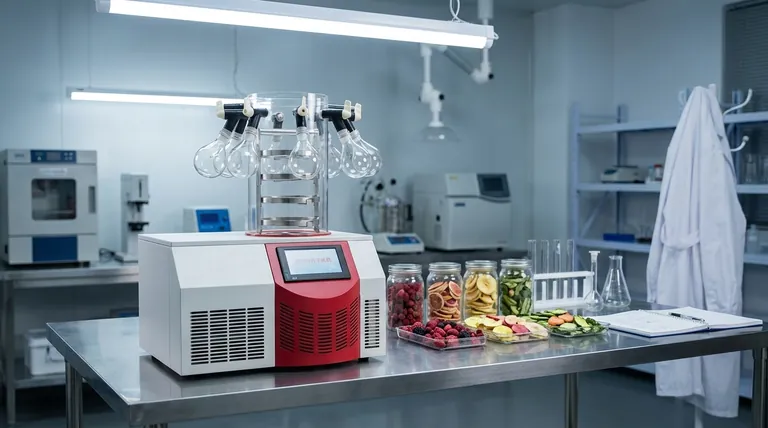At its core, freeze-drying preserves the nutritional value of food by removing water at low temperatures, a process that bypasses the damaging high heat used in conventional dehydration. By freezing the food and then turning the ice directly into vapor under a vacuum, the method locks in heat-sensitive vitamins and preserves the food's cellular structure, flavor, and aroma with remarkable fidelity.
The fundamental advantage of freeze-drying is that it dehydrates food without cooking it. This gentle, low-temperature process avoids the thermal degradation of nutrients that plagues other preservation methods, resulting in a shelf-stable product that retains most of its original nutritional quality.

The Science of Sublimation
To understand why freeze-drying is so effective, you must first understand its unique two-step mechanism, which differs significantly from simple dehydration.
Step 1: Rapid Freezing
The process begins by rapidly freezing the food product, typically to temperatures between -30°C and -50°C. This quick freeze is crucial as it forms small ice crystals, minimizing damage to the food's cellular walls. The food's structure, nutrients, and flavor compounds are essentially locked in place.
Step 2: Sublimation Under Vacuum
Next, the frozen food is placed in a refrigerated vacuum chamber. The vacuum significantly lowers the pressure, creating an environment where ice can turn directly into water vapor without first melting into a liquid. This process is called sublimation. A small amount of heat is gently applied to encourage this phase change, but it remains far below the temperatures used in conventional drying.
Why This Process Protects Nutrients
The combination of freezing and sublimation directly addresses the primary causes of nutritional loss and spoilage.
Avoiding High-Heat Degradation
The single greatest factor in nutrient preservation is the avoidance of high heat. Many essential nutrients, particularly water-soluble vitamins like Vitamin C and B vitamins, are notoriously sensitive to heat. Conventional drying methods, which use hot air to evaporate water, effectively "cook" the food, degrading these delicate compounds. Freeze-drying sidesteps this entirely.
Preserving Cellular Structure
By forming small ice crystals and then gently removing them as vapor, freeze-drying leaves the food's physical structure almost perfectly intact. The result is a porous, lightweight product that maintains its original shape and volume. This structural integrity also helps protect the nutrients housed within the cellular matrix.
Inhibiting Spoilage Without Chemicals
Food spoils because microorganisms like bacteria and mold thrive in the presence of water. By removing up to 99% of the moisture content, freeze-drying creates an environment where these microbes cannot grow. This extends shelf life for years without the need for refrigeration or chemical preservatives.
Understanding the Trade-offs
While freeze-drying offers superior nutritional retention, it is not without its limitations. True objectivity requires acknowledging its downsides.
High Cost and Energy Consumption
The primary drawback is expense. Freeze-dryers are complex, energy-intensive machines, making the process significantly more costly than traditional canning or dehydration. This cost is inevitably passed on to the consumer.
Texture Alteration
While the shape is preserved, the final texture is fundamentally changed. Freeze-dried food becomes dry, brittle, and porous. While this is ideal for quick rehydration, the original texture is never fully recovered, which may be undesirable for certain foods.
Making the Right Choice for Your Goal
Understanding the principles of freeze-drying allows you to decide when it is the most appropriate preservation method for your needs.
- If your primary focus is maximum nutrient retention and long-term stability: Freeze-drying is the gold standard, unmatched by other common preservation techniques.
- If your primary focus is lightweight food for activities like hiking or emergency kits: Freeze-drying is ideal due to its significant weight reduction and quick rehydration.
- If your primary focus is cost-effective, bulk preservation at home: Traditional methods like canning or hot-air dehydration are far more accessible and economical.
By choosing cold over heat, freeze-drying provides a powerful way to preserve the very essence of fresh food.
Summary Table:
| Key Factor | How It Preserves Nutrition |
|---|---|
| Low-Temperature Process | Avoids thermal degradation of heat-sensitive vitamins (e.g., Vitamin C, B vitamins). |
| Sublimation (Ice to Vapor) | Removes water without damaging the food's cellular structure, locking in nutrients. |
| Moisture Removal (up to 99%) | Inhibits microbial growth, extending shelf life without chemical preservatives. |
Ready to preserve the nutritional integrity of your samples?
KINTEK specializes in providing reliable lab equipment, including freeze dryers, to help your laboratory achieve superior preservation results. Our solutions are designed to maintain the quality and viability of sensitive biological materials, food samples, and pharmaceuticals.
Contact our experts today to find the perfect freeze-drying system for your research or production needs and discover how we can support your laboratory's success.
Visual Guide

Related Products
- Benchtop Laboratory Freeze Dryer for Lab Use
- Benchtop Laboratory Vacuum Freeze Dryer
- Laboratory Sterilizer Lab Autoclave Pulse Vacuum Lifting Sterilizer
- Laboratory Sterilizer Lab Autoclave Vertical Pressure Steam Sterilizer for Liquid Crystal Display Automatic Type
- Laboratory Test Sieves and Sieving Machines
People Also Ask
- What role does freeze drying play in scientific research? Preserve Sample Integrity for Reliable Results
- What is the freeze drying or lyophilisation process? A Guide to Gentle, High-Quality Dehydration
- Why is freeze drying considered more effective than ordinary drying? Preserve Structure, Nutrients & Flavor
- What is the purpose of laboratory freeze drying? Preserve Sensitive Drugs & Biologics for Stability
- What role do laboratory freeze dryers play in the food industry? Unlock Superior Food Preservation



















